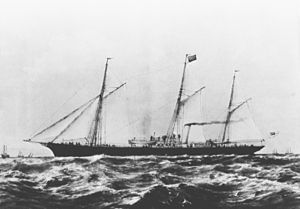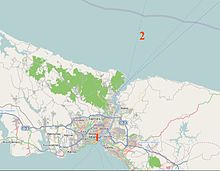Darien II was the last ship to bring Aliya Bet refugees to Haifa during World War II. A former lighthouse tender, she sailed from the Black Sea to Palestine in early 1941.
Aliyah Bet was the code name given to illegal immigration by Jews, many of whom were refugees escaping from Nazi Germany, and later Holocaust survivors, to Mandatory Palestine between 1920 and 1948, in violation of the restrictions laid out in the British White Paper of 1939, which dramatically increased between 1939 and 1948. With the establishment of the State of Israel in May 1948, Jewish displaced persons and refugees from Europe began streaming into the new state in the midst of the 1948 Palestine war.
Ruth Klüger Aliav was a Ukrainian-born Romanian and Israeli Jewish Zionist activist, assisting in the Aliya Beth before and after World War II.

The Patria disaster was the sinking on 25 November 1940 by the Jewish paramilitary organization Haganah of a French-built ocean liner, the 11,885-ton SS Patria, in the port of Haifa, killing 267 people and injuring 172.

Emanuel Litvinoff was a British writer and well-known figure in Anglo-Jewish literature, known for novels, short stories, poetry, plays and human rights campaigning.

Exodus 1947 was a packet steamship that was built in the United States in 1928 as President Warfield for the Baltimore Steam Packet Company. From her completion in 1928 until 1942 she carried passengers and freight across Chesapeake Bay between Norfolk, Virginia and Baltimore, Maryland.
David Stoliar was the sole survivor of the Struma disaster, in which the Shch-213 torpedoed and sank the Holocaust refugee ship MV Struma in the Black Sea in the early morning of 24 February 1942. All of the other estimated 781 Jewish refugees and 10 crew were killed.
The Struma disaster was the sinking on 24 February 1942 of a ship, MV Struma, which had been trying to take nearly 800 Jewish refugees from the Axis member Romania to Mandatory Palestine. She was a small iron-hulled ship of only 240 GRT and had been built in 1867 as a steam-powered schooner but had recently been re-engined with an unreliable second-hand diesel engine. Struma was only 148.4 ft (45 m) long, had a beam of only 19.3 ft (6 m) and a draught of only 9.9 ft (3 m) but an estimated 781 refugees and 10 crew were crammed into her.

MV Mefküre was a Turkish wooden-hulled motor schooner chartered to carry Jewish Holocaust refugees from Romania to Istanbul, sailing under the Turkish and Red Cross flags. On 5 August 1944 a Soviet submarine sank her in the Black Sea by shellfire, killing more than 300 refugees.
MV Domala was a British cargo liner that was launched in 1920 as Magvana, but completed in 1921 as Domala. She was the first major ocean-going passenger ship to be built in the United Kingdom as a motor ship.
Щ-213 was a Soviet Navy Shchuka-class submarine, Type X. She was built at the Sudostroytelnyi zavod imeny 61 kommunara in Mykolaiv, Ukrainian SSR, and entered service in October 1938 with the Soviet Black Sea fleet.
SS Navemar was a cargo steamship that was built in England in 1921, was Norwegian-owned until 1927 and then Spanish-owned for the rest of her career. An Italian submarine sank her in the Strait of Gibraltar in 1942.
Noemijulia was a 2,489 GRT cargo ship built in 1895 as Barlby by Sir R Ropner & Sons Ltd, Stockton-on-Tees, County Durham, England, for their own use. She was sold to Greece in 1926 and renamed Noemi. In 1930, she was sold to a British company and renamed Noemijulia. Questions about the manner of her operation were raised in the British Parliament in 1935, and she was attacked by Spanish Nationalist aircraft in 1937 off Cape de Creus.

RMS Ebro was an ocean liner that was launched in Ireland in 1914. With changes of ownership she was renamed Princesa Olga in 1935 and Serpa Pinto in 1940. She was scrapped in Belgium in 1955.

SS Patria was an 11,885 GRT French ocean liner built in 1913 for Compagnie française de Navigation à vapeur Cyprien Fabre & Cie, for whom she was first a transatlantic liner and then an emigrant ship. From 1932 Fabre Line leased her to Services Contractuels des Messageries Maritimes, who ran her between the south of France and the Levant. After the fall of France in June 1940 the British authorities in Mandatory Palestine seized her in the Port of Haifa and placed her under the management of the British-India Steam Navigation Company. In November 1940, the Zionist movement Haganah planted a bomb aboard which sank her with the loss of between 260 and 300 lives. Patria remained a wreck in Haifa port until she was scrapped in 1952.

Between 1933 and 1945, a large number of Jews emigrated from Nazi Germany and German-occupied Europe. This exodus was triggered by the militaristic antisemitism perpetrated by the Nazi Party and by Germany's collaborators, ultimately culminating in the Holocaust. However, even before the genocide itself, which began during World War II, the Nazis had widely sponsored or enforced discriminatory practices—by legislation, in many cases—against Jewish residents, such as through the Nazi boycott of Jewish-owned businesses. Although Adolf Hitler and the German government were initially accepting of voluntary Jewish emigration from the country, it became difficult to find new host countries, particularly as the 1930s were marked by the Great Depression, as the number of Jewish migrants increased. Eventually, the Nazis forbade emigration; the Jews who remained in Germany or in German-occupied territory by this point were either murdered in the ghettos or relocated to be systematically exploited and murdered at dedicated concentration camps and extermination camps throughout the European continent.
Prior to joining the Allied Powers late in the war, Turkey was officially neutral in World War II. Despite its neutrality, Turkey maintained strong diplomatic relations with Nazi Germany during the period of the Holocaust. During the war, Turkey denaturalized 3,000 to 5,000 Jews living abroad; between 2,200 and 2,500 Turkish Jews were deported to extermination camps such as Auschwitz and Sobibor; and several hundred confined in Nazi concentration camps. When Nazi Germany encouraged neutral countries to repatriate their Jewish citizens, Turkish diplomats received instructions to avoid repatriating Jews even if they could prove their Turkish nationality. Turkey was also the only neutral country to implement anti-Jewish laws during the war. Between 1940 and 1944, around 13,000 Jews passed through Turkey from Europe to Mandatory Palestine. According to the research of historian Rıfat Bali, more Turkish Jews suffered as a result of discriminatory policies during the war than were saved by Turkey. Since the war, Turkey and parts of the Turkish Jewish community have promoted exaggerated claims of rescuing Jews, using this myth to promote Armenian genocide denial.
V 305 Ostpreussen was a German fishing trawler that was requisitioned in the Second World War by the Kriegsmarine for use as a vorpostenboot and later a Vorpostensicherungsboot. She was returned to her owners post war. In 1957, she was re-engined, converted to a cargo ship and renamed Stella Maris. Sold to the Netherlands that year, she was scrapped in 1958.

SS Flandre was a French transatlantic ocean liner of the Compagnie Générale Transatlantique. (CGT). She was launched in 1913 and sunk in 1940. Her peacetime route was between France and ports in the Caribbean.

The second USS Cythera (PY-31) was a United States Navy patrol vessel in commission from 1942 to 1944 and in non-commissioned service from 1944 to 1946. She also served in the Israeli Navy as INS Ma'oz from 1948 to 1956.












